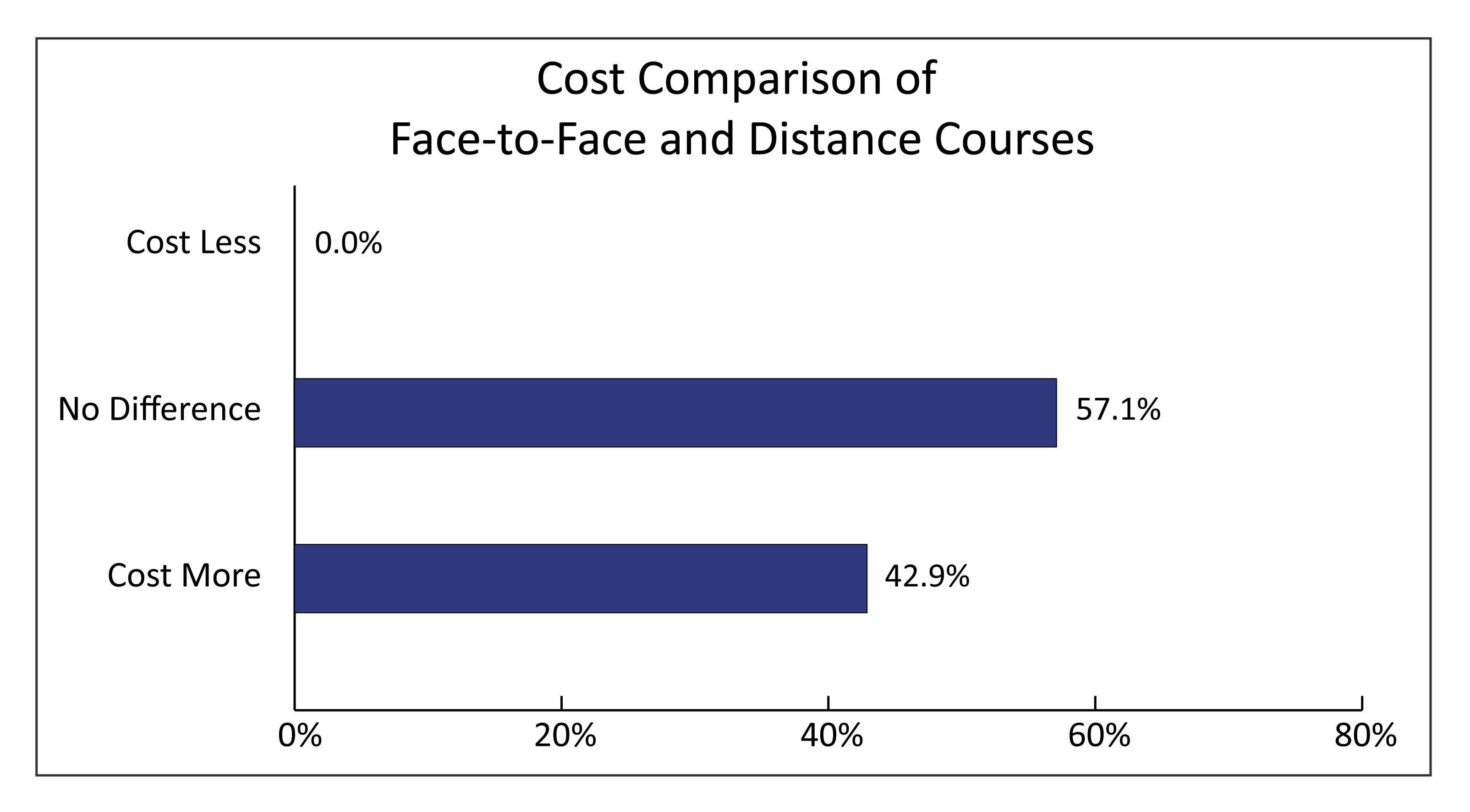Distance Ed Costs and Price: Not as Closely Correlated as You’d Think
Published by: WCET | 2/16/2017
Tags: Cost Of Instruction, Research, Survey, WCET
Published by: WCET | 2/16/2017
Tags: Cost Of Instruction, Research, Survey, WCET
What do you know about the price and cost of distance education? What do we charge students (the “price”)? How much does the institution spend to create the course (the “cost”)? In order to learn more about this issue, WCET conducted a survey with colleges and university leaders regarding the price and cost of distance courses.
Today we welcome Russ Poulin and Terri Taylor Straut to introduce the WCET Distance Education Price and Cost report. Today’s post will provide background on the survey and an overview of the results. Join us again soon for more in-depth discussions of results and Russ and Terri’s commentary on this important work.
Enjoy the read,
~Lindsey Downs
The long-held belief among legislators, governors, and other leaders is that distance courses should cost less to produce and deliver. Therefore, they assume that the price paid by students enrolled in these courses should be less than courses taught on campus.
WCET’s Steering Committee wanted more data about this issue. A committee (Joan Bouillon, Pearson; Tom Cavanaugh, University of Central Florida; Preston Davis, Northern Virginia Community College; and John Opper, Florida Virtual Campus) helped WCET staff identify the question for a survey of distance education professionals conducted last year.
Today, we release the results of that survey, additional interviews with higher education costing experts, and an in-depth report on the politics surrounding these issues in one state. As you will see in our concluding opinions, WCET’s Distance Education Price and Cost report is meant to provoke additional dialogue.
The reality at most institutions, according to the WCET survey, couldn’t be further from the truth with more than half (54.2%) of our respondents reporting that distance students pay more than on-campus students when tuition and fees are added. About three-quarters (75.1%) of institutions who completed the study indicated that tuition was the same, but the added fees continue to result in the price to students of distance courses being more.

The WCET report provides in-depth analysis of the issues of cost and price based on our survey and interviews with industry experts.
The analysis provides enough data and differing opinions to challenge the perspectives of just about anyone who reads it. It’s our belief that all parties involved in setting the price for distance education courses need a dose of the realities that the “others” are facing. This report provides those differing perspectives.
A common understanding of the terms used is essential. Survey respondents were given the following definitions in the introduction to the survey:
Our survey of distance education professionals asked detailed questions about the cost of twenty-one components in four categories (preparing, teaching, assessing students, and supporting faculty and students) of creating and delivering distance courses.  The results reveal that for twelve (57.1%) of the components the respondents thought there was no difference in the costs. For nine (42.9%), of the components respondents thought that distance courses cost more and, in some cases, much more. Respondents did not identify a single component of a distance course at their institution that costs less.
The results reveal that for twelve (57.1%) of the components the respondents thought there was no difference in the costs. For nine (42.9%), of the components respondents thought that distance courses cost more and, in some cases, much more. Respondents did not identify a single component of a distance course at their institution that costs less.
Along with the survey of distance education professionals, we conducted interviews with higher education experts who have done extensive research and thinking on the higher education cost issue. Most of those experts who we interviewed challenged the status quo thinking that the cost of distance courses must be higher. They echoed an opinion that we heard from a few of the distance education professionals that many of the technologies and practices that began in distance courses are becoming ubiquitous across campus and the cost differences are lessening. In fact, some of them contend that when distance courses are designed from scratch, without trying to emulate the classroom model, they can be both more effective and cheaper.
Historically, distance education’s mission has been to overcome the barriers of place or time. The mission was not to control costs. In fact, to reach some locations is costly. Distance education should not be held accountable to a mission it was never given.
In recent years, governors and legislators have openly wondered about the price and cost equation. Decreased state funding has often been replaced by increases to tuition and fees.  Now that their constituents are complaining about affordability, they are asking uncomfortable questions. Meanwhile, distance education professionals are caught in a higher education economics ethos that shuns open examination of price and cost…and are expected to answer to a “controlling cost” mission that was not given them in the first place.
Now that their constituents are complaining about affordability, they are asking uncomfortable questions. Meanwhile, distance education professionals are caught in a higher education economics ethos that shuns open examination of price and cost…and are expected to answer to a “controlling cost” mission that was not given them in the first place.
Russ Adkins, distance education expert and long-time friend of WCET, volunteered to add a chapter updating the actions over the last few years in his home state of Florida. The issues of cost and price have become very political there. The Florida Legislature created UF Online that is mandated to charge a price that is 25% lower than its on-campus counterparts. The Governor capped the distance education fees and threatened to eliminate them. A task force was created to examine distance education costs. Will other state’s follow suit?

The report presents different points of view both in the status of how things are and how they could be. There are sections that will encourage and annoy all readers.
Comment on this post. You can offer to write a post that outlines price and costs in your settings. WCET members should watch for a discussion item on these issues on Friday. Suggest other resources.
We will be talking about these issues throughout the year. Watch for more.

Terri Taylor Straut
Senior Research Analyst
State Authorization Network
WCET – WICHE Cooperative for Educational Technologies

Russ Poulin
Director, Policy and Analysis
WCET – WICHE Cooperative for Educational Technologies

Save
Save
Images shared under CC license. Thank you! Credits:
Piggy Bank
Conversation 1
Conversation 2
13 replies on “Distance Ed Costs and Price: Not as Closely Correlated as You’d Think”
[…] less to produce and therefore save students money on tuition doesn’t hold up to scrutiny, a survey of distance education providers […]
[…] cost less to produce and therefore save students money on tuition doesn’t hold up to scrutiny, a survey of distance education providers […]
1) Separate the overhead of brick space from a truly virtual program (e.g. Straighter Line (SL) vs both amortized capital and operational costs of a “campus” including non-academic programs and facilities including support services such as dorms, food services, grounds and student services including recreation
2) With blended learning or virtual (e.g. SL or Kahn Academy /KA) distribute development costs of professionally developed materials over the lifecycle costs of bricks vs clicks
3) Disaggregate labor costs (as suggested) changing educational model and using appropriate faculty from tenure track to non tenure track to adjuncts. Reassess the current admin overhead costs needed including facilities management
4) Except for programs like SL or KA, all institutional online courses are “bolted on” to various degrees and buried in the dist ed costs.
The only way to get at these costs is to have a professional audit separate from the anecdotal and semi measures extracted by this survey
[…] less to produce and therefore save students money on tuition doesn’t hold up to scrutiny, a survey of distance education providers […]
[…] cost less to produce and therefore save students money on tuition doesn’t hold up to scrutiny, a survey of distance education providers […]
[…] R. and Strauss, T. (2017) Distance Education Price and Cost Report Boulder CO: […]
[…] cost less to produce and therefore save students money on tuition doesn’t hold up to scrutiny, a survey of distance education providers […]
[…] R. and Strauss, T. (2017) Distance Education Price and Cost Report Boulder CO: […]
[…] cost less to produce and therefore save students money on tuition doesn’t hold up to scrutiny, a survey of distance education providers […]
[…] Given WCET’s recent work on the cost and price of distance education, it is notable that economic considerations have become a factor in this review process. We can […]
[…] and Terri Taylor Straut introducing the WCET Price and Cost of Distance Education report. The post, Distance Ed Costs and Price: Not as Closely Correlated as You’d Think, provided background on the survey and summarized the results. Watch for a Change Magazine article […]
[…] A study published last year by the WICHE Cooperative for Education Technologies (WCET) surveyed nearly 200 educators and administrators who “are on the front lines of offering distance courses.” They found that, “more than half (54.2%) of our respondents report[ed] that distance students pay more than on-campus students when tuition and fees are added. About three-quarters (75.1%) of institutions who completed the study indicated that tuition was the same, but the added fees continue to result in the price to students of distance courses being more.” […]
[…] overall costs, has actually increased in many cases due to high production costs. According to the WCET Distance Education Price and Cost study, 54.2% of respondents reported that commuting students pay more than on-campus students when […]